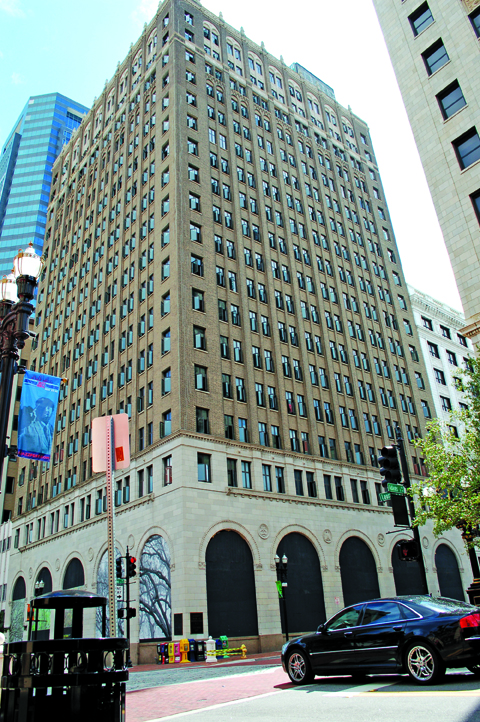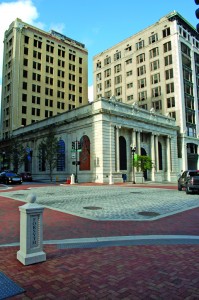Downtown’s Laura Street Trio, Barnett Bank Building face uncertain future
Posted on June 4, 2013 By Editor Articles, Neighborhood News, Top Stories
City’s dry bones need modern-day Ezekiel
The Old Testament tells of a prophet named Ezekiel who saw dry, lifeless bones in a valley. God gave him a vision and told him to prophesy to the bones. When Ezekiel did, the bones connected to each other, stood on their feet and became a great army.
The Laura Street Trio – the Marble Bank Building, the Florida Life Building and the Bisbee Building – plus the old Barnett Bank Building could be likened to those parched bones.
Purchased in April by a development company headed by Stephen Atkins and backed by Jaguars owner, Shahid Khan, the buildings stand silent and tomb-like at the corner of Laura and Forsyth Streets on a block forgotten by commuters racing past.
The acquisition may represent growth for Jacksonville’s downtown, and Atkins might be a prophet foretelling the City’s future.
Downtown momentum
Wiat Bowers is an urban planner with a local consulting firm who purchased a home in Jacksonville’s urban core in 2006. Downtown was on the cusp of exploding in a good way, he said.“Then, the recession hit, and that stymied everything.”
Now, though, Bowers sees momentum downtown in two ways. April’s One Spark Festival was the first because it brought over 100,000 people into the heart of the city. Second is the ongoing conversations started by the JAX2025 initiative sponsored by Jacksonville Community Council Incorporated (JCCI).
In addition, Mayor Alvin Brown launched the Downtown Investment Authority last year.
History and architecture
All four edifices were built in the first quarter of the twentieth century, a time of growth in Jacksonville following the devastating 1901 fire. The same year, architect Henry John Klutho moved to Jacksonville to help the city rebuild.
The Florida Life on Laura Street and the Bisbee on Forsyth Street were designed by Klutho. Both structures are narrow with a heavy base of reinforced concrete, which supported the height of the buildings, according to Catherine A. Duncan, an architect based in St. Augustine. Both follow the Prairie School of architecture.
“I would consider [them] to be modeled after Louis Sullivan, an architect who practiced in Chicago and developed the idea of the skyscraper there. Those buildings are Jacksonville’s first skyscrapers,” Duncan added, “and they were very cutting edge at the time.”
The Old National Bank Building also known as the Marble Bank Building on the corner of Forsyth and Laura was designed by architect Edward Glidden in 1902. Built in the Neo-Classical Revival style, the structure’s exterior and its columns are covered in marble.
After it was built, a spectacular skylight was added. It was covered over in the 1950s when two dropped ceilings were added, according to “Jacksonville’s Architectural Heritage: Landmarks for the Future” by Wayne W. Wood.
In 1978, Jacksonville architect, Robert C. Broward, returned the interior to its original glory. Broward removed barriers to the skylights in the Marble Bank Building as well as in the St. James Building, the current City Hall.
Unfortunately, the skylight in the Marble Bank Building is now broken, and there is flood damage.
“They’re all important buildings,” Duncan added. “They’re very significant in the history of architecture in Jacksonville.”
The Barnett Bank Building on West Adams was designed by a New York architectural firm in the middle of a Jacksonville building boom. Finished in 1926, it became Jacksonville’s tallest building at 18 stories. The landmark was popular to locals because of the lighted clock sitting atop its roof.
“It’s a blank slate now,” Bowers said of the gutted building. He foresees it becoming a mixed-use building, perhaps including a boutique hotel, offices and condominiums.
Current Status
The Resident Community News attempted to reach Stephen Atkins for comment on his intention to announce his plans for the buildings at the One Spark event. Atkins did not announce those plans, however, and his phone was indicated as being disconnected.
In a 1965 WJXT-produced program, “The Choice: An Essay on Downtown,” Jacksonville architect, Taylor Hardwick, said planning was crucial to creating a vibrant downtown. “We’ve got to make Jacksonville a human place-a place with variety and delight, and a place where people will want to work instead of having to work here, and even a place where people will want to live.” To Hardwick, that meant investment in planning for the future.
Future
Bowers is cautiously optimistic about downtown. “What we need is more foot traffic, day, night and weekend,” Bowers said. “A revitalization of the Laura Street Trio with the Barnett Building offers that in a way other buildings, such as the Haydon Burns Library, don’t.” The Marble Bank Building would work well as a fine dining establishment, Bowers said, because of the character of its construction and the balcony-like arcade.
As for Bisbee and Florida Life, Bowers appreciates their limitations. “There’s only 1,000 or so square feet per floor. They could work for small users or start-up companies with two or three employees, or there could be two or three apartments per floor,” he said, “but both buildings are too small for any big name corporation,” he said.
Architecture isn’t the only challenge, though. Planning is another one.
Bowers agrees. The City has spent lots of money on the stadium, the new library and the Times-Union Center, he said, but the focus of the building has not been concentrated.
Potential
Perception is another challenge. The assumption is downtown living means in a high-rise, but it doesn’t, Bowers said. He lives at The Parks at the Cathedral, a townhome community across from St. John’s Cathedral east of Main Street. Bowers is also the homeowner’s association president. “Look at the Parks,” he said. “It’s gated; it has trees, grass and a pool.”
Yet another obstacle is parking. None of the Laura Street Trio has parking directly associated with it. Although in downtowns across the country, people expect to walk some distance between where they park and where they’re going, Bowers added.
Broward, who studied with Klutho, was also interviewed in WJXT’s 1965 program. “The real question is,” he said then, “will [downtown] be a thing of quality, or will it be a mere unrelated mass of buildings without regard really for the poetry of human life?” The same question could be asked today.
Whether Atkins is a modern-day Ezekiel beholding God’s vision of Jacksonville’s dry bones remains to be seen.




 (1 votes, average: 4.00 out of 5)
(1 votes, average: 4.00 out of 5)






